July Golden Apple
JULY GOLDEN APPLE
(Malus domestica)

July Golden Apple
Grant Merrill introduced many fruit varieties at the California Research Station in Red Bluff, CA. He retired and moved to Visalia and gave a new apple tree he was researching to a neighbor of ours. They were to grow it and he would review it later. Unfortunately he passed away.
This variety was a Golden Delicious apple that produced large quality apples in July. His review was to see how it produced in our hot valley before the long summer heat. The neighbors knew it had never been introduced and did not want it lost, so the L. E. Cooke Co started production.
The L. E. Cooke Co first grew July Golden in 1973-74. July 1975 we planted the trees in our Cooke 1 orchard. It became a good producer of large apples. To have our sales staff see and eat the apple, we planted a tree next to the lab office, right outside the sales door. The sales staff did the pruning to keep it as an EZ-Pick demonstration tree.
The tree set very abundant crop of large apples in early July so customers could see them. One of the salesmen saw them dropping each day and boxed them for my wife to make apple sauce.
Even though the sales staff got carried away pruning, they saw lots of apples on the 2 year wood. None were harmed by the summer heat when over 100°. The early season ripening helps a lot and the foliage protected them similar to a spur apple.
Facts:
The fruit is large golden-yellow crisp good tasting apple resembling the fall Yellow Delicious. It produced apples in early July after 100° weather in late May, June, and July. The early season ripening and the foliage protected the apples which had no heat caused blemishes. They were crisp quality flesh.
This is another great choice for our hot valley and similar climates in other states where they have 600 or more chill hours.
The L. E. Cooke Co was very fortunate to learn of this new July Golden Apple. Why wait to September for your apples? They make good apple sauce and pies.
Bob Ludekens
1/26/15
Additional Photos: July Golden Apple
Information Page: July Golden Apple Information Page
Autumn Royal Apricot History
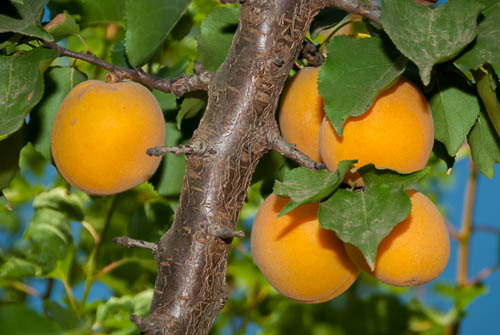
AUTUMN ROYAL APRICOT
L. E. Cooke Patent #2906
Andrew W. Kannonin, Hollister, California had a Blenheim Apricot orchard. In the orchard was a tree with one sport limb that flowered similar to the rest of the tree but the fruit did not ripen until September 15.
Nephew Don Moore (Moore's Western Nursery in Atascadero, CA) shared this information with Bob Ludekens who, along with business partner George Daniels, drove to Hollister to see the fruit quality. We budded a few trees and planted in our research orchard. In our San Joaquin Valley the fruit ripens in late August. The company filed for a patent December 18, 1967 and patent was granted July 15, 1969.
The Autumn Royal produces a Blenheim Apricot into mid September depending where it is planted. This is the latest known apricot making it very unique. The tree should be grown in climates such as the San Francisco Bay area to inland in Southern California.
Autumn Royal is not a good choice for the >100° F. Central Valley where it will pit burn and split open in the summer. In a normal summer we can have fruit from our larger trees that shade the fruit. When the tree is small the fruit can pit burn or when 115° the fruit splits open.
Autumn Royal does well in the Royal/Blenheim areas where the summer heat is normally less than 100°, such as Montebello, Whittier, San Gabriel, Vista, inland coastal areas with enough chilling for Blenheim. The fruit is the fine quality of Blenheim/Royal Apricot.
Most all apricots are ripening in June/July with a few new selections now in May. Autumn Royal is the only selection we know of after July and mid September makes it very unique.
Robert Ludekens 12-26-2013
Autumn Royal Apricot Information Pags - Point of Sale Page
Golden Amber Apricot History

GOLDEN AMBER APRICOT
L. E. Cooke Patent #3067 (Filed September 18, 1969)
Willard Clayton Hill had a Tilton Apricot orchard on Caldwell Ave, Visalia, California. He told Bob Ludekens about one tree in his orchard that flowered over a 30 day period and produced apricots ripening for 30 days. The extended time was not good for commercial plantings but is what a homeowner would want. When a tree has fruit ripening all in a few days, most is lost by the homeowner as they prefer to pick their fruit over a longer period, similar to berries.
Golden Amber produces the large fruit similar to a Tilton and is great for hot areas as it is the only late (July) fruiting apricot that does not pit burn in the May/June/July 100° weather of our san Joaquin Valley. The fruit is strong flavored and freestone that makes great halves with no soft flesh in the pit area from heat.
The 30 day bloom period is an advantage in the areas with late spring freezes. The spring freeze may get some flowers but others still fruit.
The tree is not a showy flowering trees since the bloom is spread over 30 days but has a high quality fruit in areas with late spring freeze and 100° May/June heat that pit burns most apricots. Golden Amber produces very large solid fruit with great flavor. The variety is a top choice like Tilton for dried apricots as they make good halves with strong flavor. Also it is excellent as frozen fruit and great on waffles in the winter. Tilton and Golden Amber are the only apricots Mrs. Robert Ludekens chooses to pick with 18 varieties close to their home.
1. Prolonged progressive blooming.
2. Prolonged progressive fruiting.
3. Pit burn resistant.
4. Large size fruit.
5. Excellent flavor.
6. Self fertile.
7. Good halves for drying, freezing, etc.
Robert Ludekens 12-26-2013
Royalty Apricot History

ROYALTY APRICOT
This very large early fruiting apricot was introduced to the L. E. Cooke Co in 1970 by Walter Krause of Redwood Nursery, Reedley, California.
Royalty sets fruit as a young tree and ripens for us in early June. The tree sets very large fruit on the heavy wood in the tree which is an asset in windy areas.
The variety is freestone, self fertile, very large, good flavor, ripening very early before the summer heat. The original trees were sold by Mr. Krause in Idaho, Utah, Michigan and the California San Joaquin Valley. While the fruit quality is large and excellent flavor, the tree does not set a heavy crop. Fruit size mitigates some of this.
Robert Ludekens 12-26-2013
Moniqui Apricot History

MONIQUI APRICOT
Mr. Andy Mariani , Mariani Orchards in Morgan Hill, California, supplied budwood for this variety during the summer of 1990.
Moniqui is from Spain. It grows in areas with chill from 600 to 1000 hours. A very unique fruit with sweet white juicy flesh with a coral pink blush to the skin with golden highlights on both ends.
The tree is a very vigorous grower, large leaves, resistant to bacterial canker. The fruit is large with tender white flesh and thick firm skin which makes it suitable for fresh market. Flesh has a sweet, melon like flavor and melting texture.
The variety does not seem to be as susceptible to normal apricot disorders with very little evidence of brown rot, sunburn, or pit burn.
Large size, white flesh, sweet dessert quality makes the fruit a good home variety.
Robert Ludekens 12-26-2013
Autumn Rosa Plum History

AUTUMN ROSA PLUM
The Autumn Rosa Plum is medium to large heart shaped fruit. The skin has a bloom similar to some grape varieties. When the bloom is removed, the skin is very shiny maroon to red with an amber cast. If the fruit is in full sun it is very maroon, if in the shade has more red with the amber shading.
The flesh is amber color, moist but very firm, and a heavy fruit for its size. The pit is small resulting in an abundant amount of excellent flavored flesh. The fruit ripens over a long period and holds well on the tree. The fruit is ripe from early to late September. 400 to 500 hours of chill is necessary. The tree is self fertile and is a pollinizer for Mariposa and Satsuma plums.
Autumn Rosa is the latest ripening of our current plums which means many hours of sun building sugar and flavor. I personally prefer this variety to Santa Rosa for flavor and specially the moist smooth golden flesh with the small pit and not dripping juicy.
It is unfortunate there is not more interest in the variety with the late ripening. If it was an earlier variety it would be well known and possibly the #1 seller. The tree blooms the same time as Santa Rosa, so likely grows in the same areas. Unfortunately plum flowering dates are not as accurate to indicate chill hours as are peach and nectarine dates.
L. E. Cooke Co received budwood from commercial fruit tree breeder Fred Anderson. It was rejected for commercial use because it fruited over a long period and the farmers could not have the desired one time picking for market. This is exactly what the homeowner wants. The bloom on the fruit would discourage a farmer where a homeowner approves of the polished shine and bright colors. The fruit is good for farmers' markets as it holds well on the tree and on display or in storage.
Bob Ludekens 2-11-2014
Thumbs Up
Today we culminated a week of sales training with a walk through the fields and budwood orchards.
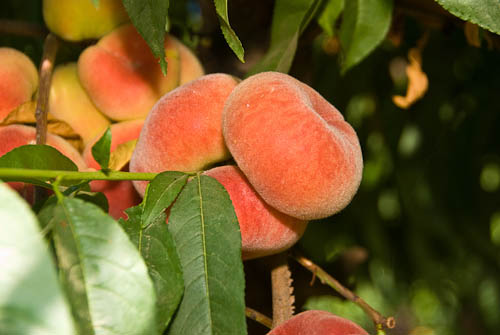
As we passed the ripe Donut (Saturn) Peaches and were refreshing ourselves with their sweet, sugery goodness, I recalled a conversation I had with a customer earlier this year in Texas. As I was describing the improvement of size and flavor of the Galaxy Peach over the Donut Peach, he commented, "can you pop the seed out of the Saturn Peach like I do with the Donut Peach?"
"Huh?"
"Yeah, I use my thumb and pop the seed right out of the peach and it looks like a donut - hole and all. Now you can eat the whole thing."
Since I had never tried this or heard of such a thing, I plead ignorance.
Today, we got to try it. Or at least Kevin did while we watched. (As the newest member of our sales staff, he gets volunteered for a lot of things.)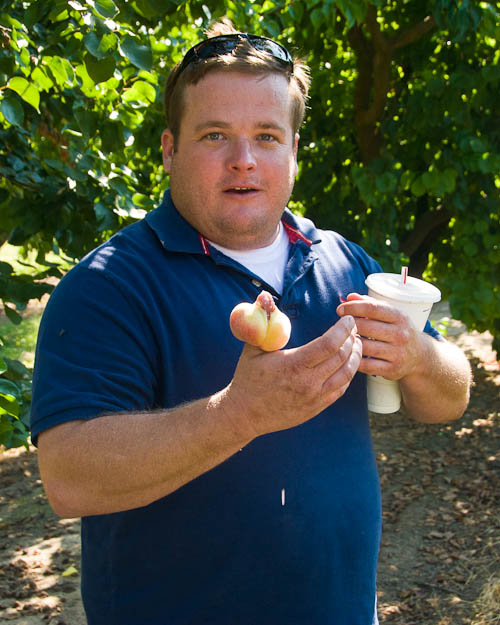
Guess what, it works! 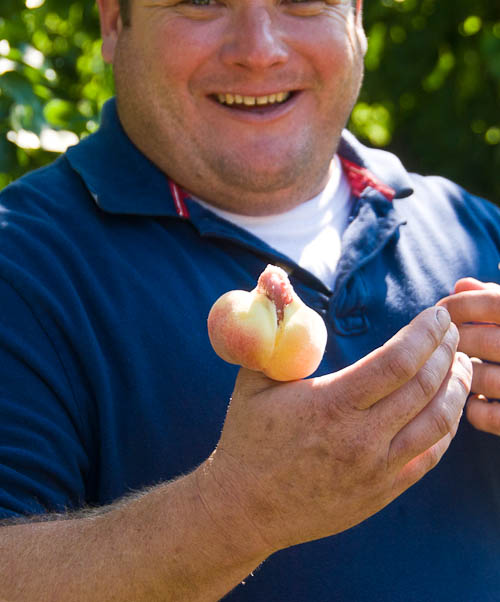
Seed is gone. Now what?
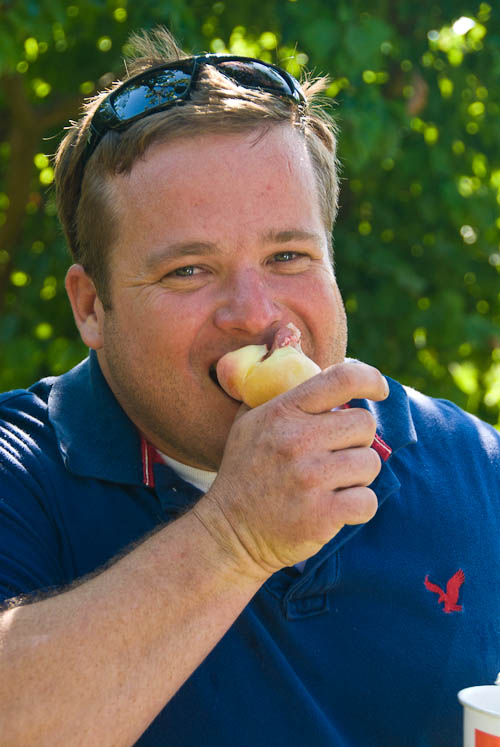
Seems a new way to eat Donut Peaches has been discovered.
What about the Galaxy Peach?
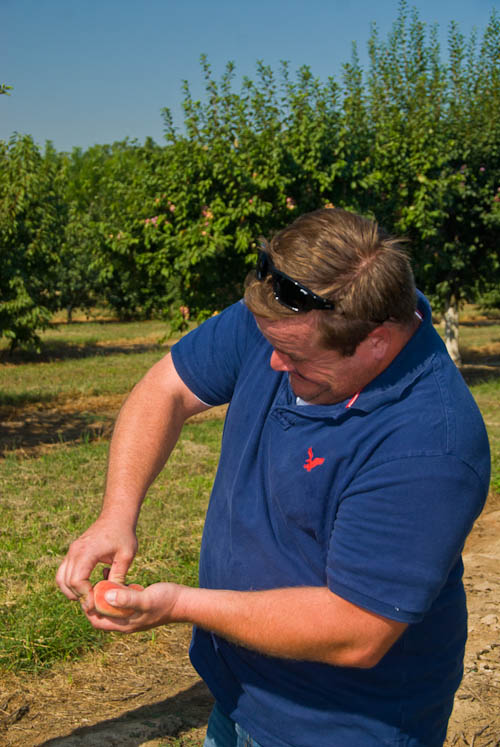
Here is Galaxy Peach. Larger for sure. But about a week or so before it is fully ripe. Peach pits do not pop well out of hard, unripened peaches - so we decided to save Kevin's thumb for another week. To be continued....
Ron Ludekens
Seminar: "Your Sustainable Backyard - Fruit Trees"
On what was supposed to be a hot Friday in August, I had the pleasure of participating in the first, hopefully annual, seminar presented by the California Center for Urban Horticulture, "Your Sustainable Backyard: Fruit Trees"
This event sold out very fast. I would guess that this is mainly due to the huge amount of interest in fruit that is happening right now, and partially because the event was held off of the Davis campus at the Wolfskill Experimental Orchards site in Winters.
Wolfskill is a 170 acre experimental station that U.C. Davis and USDA-ARS jointly occupy. Davis is doing breeding work there, and ARS keeps its fruit germplasm repository here. The draw here is that this site has been used by the University for over 80 years, and virtually no one has been allowed on site except for small, select groups. For example, about 15 years ago, the deciduous growers of CA held a meeting there to review some of the varieties in the repository for trueness to type, and none of us have been back since. Until now, that is.
Fruit Tasting
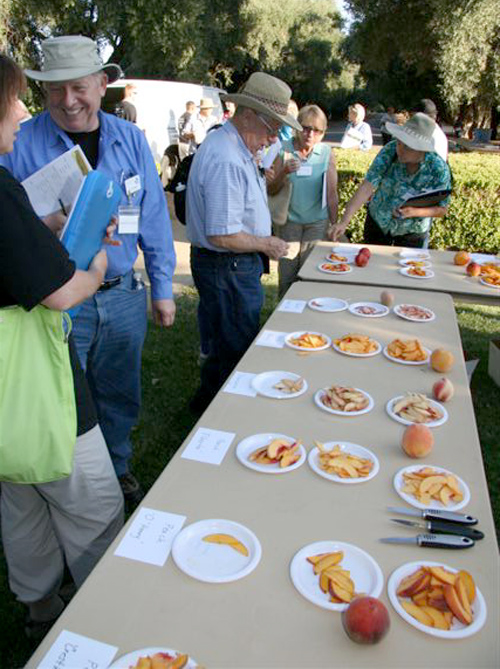
The day, which turned out to be temperature perfect in spite of all of the worry about heat, began in the cool of the morning with fruit tasting. I took some ripe-on-the-tree selections of peach (Champagne, Indian Blood Cling, Elberta) Elephant Heart Plum and Hosui Asian Pear. Champagne Peach was a real big hit.
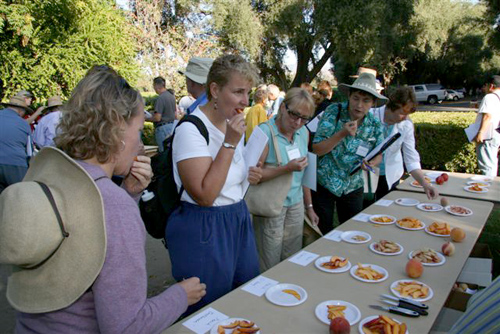
The Foundation Plant Service brought over some different selections of peaches and plums from their collection. We were also treated to some deliciously sweet European Plums (aka prunes), fresh off of the trees that the University is currently trialing for release as new patented varieties. Everyone had enough fruit to go around. There were also scones, but honestly, after the fruit, they just didn't do it for our group!
Hands On Training
There are really no classrooms or meeting rooms on the site, so we did a general meeting under the shade of some of the original trees that the Wolfskill family planted there in the 1850's. Hickory and a pecan that was 6' in diameter, and God only knows how high, because I couldn't see the top! That tree would have provided the entire group enough shade by itself, but the Hickories added the lower canopy shade to set it up perfectly. After a little history of the site, we broke into groups for in depth, hands on lessons by proven leaders within the university.
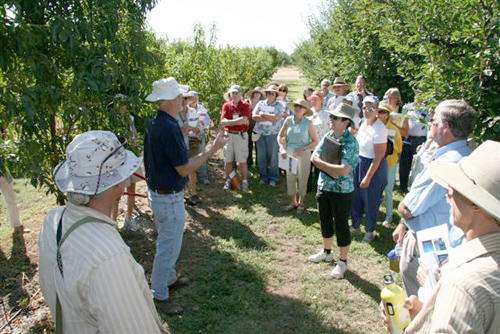
Outdoor Classroom
I went with the group that was going to learn about small space fruit production and summer pruning. This was taught by Ted DeJong, Professor of Pomology, who helped to develop the vase pruning techniques that are commonly used in orchards today, and Chuck Ingels, UC Co-operative Extension for Sacramento County. It was a perfect match of instructors as we soon found out.
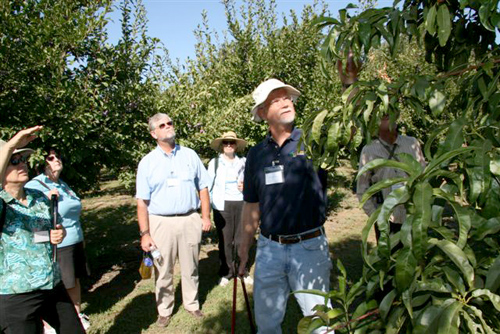
We started off by discussing what to do when you first get a tree from the nursery, either bare root or container, and what pruning should be done and why. While most of the audience were Master Gardeners, it was amazing to see how many were not exactly sure what to do when they get a tree. No wonder the EZ-Picks are so popular! We do the figuring out for you!
Ted Showing How to Prune a Young Tree
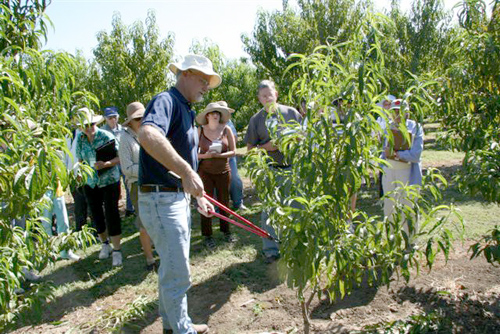
Multiple budded trees were then brought up, and Ted told the audience that his experience was that one or two would become dominant soon and choke out the others. I chimed in that this has mainly been our experience as well, but that Apples and Pears were easier to manage than stone fruits. Many in the audience also chimed in with similar frustrations. Ted then went through the concept of planting different varieties in a close space, like our 4-in-1 concept. This way, you get exactly what you want, and not what I picked out for you. More on 4-in-1 trees here: 4-in-1 Fruit Trees
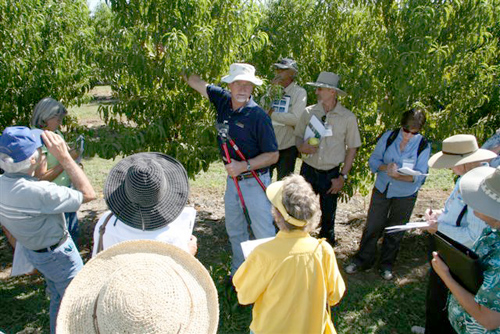
How to look for Water Shoots
Then we went hands on walking tour through the orchards. Ted showed us how to prune in 5 minutes, summer pruning, looking for water shoots that do not have spurs on them (where next year's fruit will be) and helping to keep the tree down in height, so you don't need a ladder for most of the fruit. He and Chuck went through this with several different types of trees, keeping it to where everyone in the group made sense of it, and we are all ready to go home and prune our trees better than ever! I have heard many lectures by some very distinguished horticulturalists over the years, and this was the most thorough talk I have ever been involved with. You learned the philosophy behind what you were doing, and then the how to do it as well, so you know why you are doing it and what you are doing. All in 30 minutes of walking through the orchard.
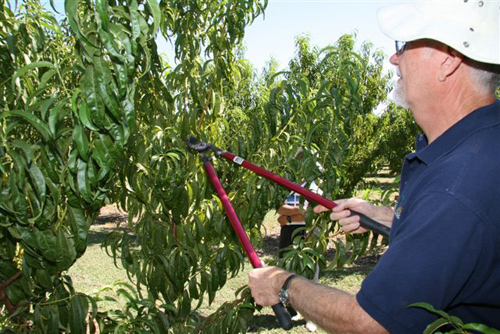
Dr. DeJong selects his cut
There was a separate talk at the same time on budding and grafting. I did not attend that. I thought that listening to the budding talk would make my knees hurt, as I have been on them plenty over the years making sure that our budders keep the buds as close to the ground as possible, to give you the best tree we can. Besides, they let everyone play with knives to try their own hand at the grafting, and I was afraid I would cut myself.
There was also a session on low impact pest management. The goal here was to help everyone understand that while there are a few things you have to watch on fruit, it is not a major issue to care for them. Typically, a dormant spray with a horticulture oil and a copper based spray will take care of most of the pest issues all year for the backyard farmer. Generally, the pests that are treated for commercially are not a big enough issue to bother the homeowner who is growing the fruit for a different purpose, to eat rather than ship.
The day was magnificent, and the discussions tremendous, and the new friends made and a couple of acquaintances re established made the event one of the more memorable of the year for me. David H. Cox
(Photos courtesy ofJohn Stumbos, U.C. Davis)

